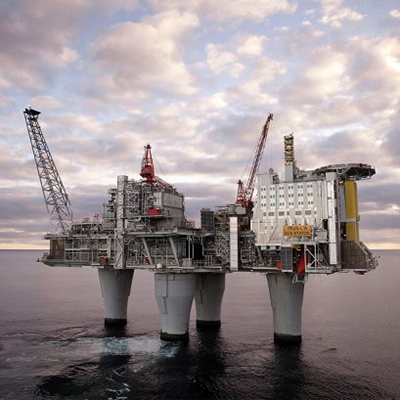Sites
The Oil Platform
Mohsen Shir Muhammad
160 دورہ
During the eight-year Iran-Iraq War, Iraq sought to attack Iran’s oil platforms in the Persian Gulf and disrupt oil production and exports. However, despite carrying out numerous attacks, it did not succeed.
An oil platform is a massive offshore structure equipped with facilities for drilling oil wells, extracting oil, and processing it. Oil platforms are used to temporarily store the extracted oil until it is transported to the shore and refined at refineries. They can be fixed to the seabed as artificial islands or float on the water.[1]
There are 159 offshore oil platforms in Iran including 29 major production ones in the Behregan region (Hendijan, Behregansar, Nowruz, Soroush, and Mahshahr fields), Khark (Forouzan, Abuzar, Doroud, Esfandiar, Arash, and Farzad fields), Siri region (Alvand, Esfand, Sivand, Dena, Nosrat, Farour A and B fields), Lavan region (Resalat, Reshadat, Salman, Balal, and Alpha fields), Qeshm island (Hengam, Hormoz A, B, D, and F, and Tousan fields), and Kish island (Kish gas field).[2]
Oil platforms are managed by the Iranian Offshore Oil Company. This company was founded in 1981 based on a resolution of the Revolutionary Council and following the abolishment of partnership contracts made during the Pahlavi era with multinational companies. The company came into operation when the Iran-Iraq War broke out.[3]
With the onset of the war, Iraq began attacking Iran’s oil facilities. Initially, Iraq was not able to carry out attacks on a large scale as its navy forces were not capable enough, and it had to rely on its air force to target Iran’s oil facilities. The structure, equipment, and missiles of Iraq’s air force were not suitable for attacking ships and oil terminals. However, despite such limited resources and capabilities, the Iraqi army repeatedly attacked Iran’s oil facilities in the Persian Gulf.[4] Between 1980 and 1985, the facilities in the Behregan and Khark regions were targeted more than other Iranian oil fields.[5]
The Nowruz oil field (in the Behregan region, northern Persian Gulf) and its well platforms were hit by Iraqi missiles more than 10 times, sustaining significant damage. On February 18, 1983, this platform was completely damaged.[6] As a result, approximately 9 million barrels of crude oil were lost. Due to the intensity of the explosions, at platforms No. 5 and 9 alone, about 6000 to 10000 barrels of oil were burning daily.[7] However, through the efforts of the Ministry of Petroleum’s personnel, two wells in the Nowruz oil field were extinguished on March 12, 1983.[8] While trying to control the well fire, several employees of the Iranian Offshore Oil Company were martyred due to enemy attacks.[9]
In the early days of 1983, Iraq once again attacked the Nowruz oil wells, causing the oil spill to spread to the coasts of Kuwait, Bahrain, and the United Arab Emirates. However, these countries did not take a stance against Iraq’s actions.[10] Once again, on May 25, 1983, Iraq attacked two oil platforms in the Nowruz region. The attack on Nowruz oil well No. 3 caused a daily leakage of 2000 barrels of oil into the Persian Gulf. After 3 months and 12 days by September 1983, the employees of the Tehran refinery managed to control the fire.[11]
The Behregansar production platform (in the Behregan region, northern Persian Gulf) was attacked by enemy aircraft four times during the war (in 1982, 1985, 1986, and 1987),[12] resulting in complete damage to its residential and operational facilities.[13]
The superstructures of five offshore platforms in Hendijan (in the Behregan region, northern Persian Gulf) were also targeted between 1982 and 1987, sustaining a total of 20 percent damage.[14]
The operational facilities and the main platform of the Soroush field wells (in the Behregan region, northern Persian Gulf), located on the Pasargad Barge, became unusable after an enemy attack in 1983.[15]
The Abuzar oil field (in the Khark region) was also continuously targeted by Iraq during the Iran-Iraq War. On October 24, 1985,[16] the Abuzar platform was attacked by the enemy, leading to a fire and the destruction of the rest area and platform No. 11. In this attack, two employees of the company and several crew members of the Badr Ship were martyred. Due to the large number of wells on the Abuzar platform and the existence of significant amounts of gas, all Abuzar wells were secured in 1983 with cement injection. Except for one case that was immediately contained, no fires occurred during enemy attacks.[17]
As the war continued, Iraq’s air force capabilities increased with access to various modern weapons, enhancing its ability to strike Iran’s oil facilities in the Persian Gulf. The acquisition of French aircraft and missiles enhanced the Iraqi air force’s capability to attack Iran’s oil export centers.[18] Between 1986 and 1988, as the war expanded to the Lavan and Siri regions, the offshore facilities of the Reshadat, Resalat, Salman, and Siri fields were also targeted by Iraq and the US Navy.[19] On November 14 and 18, 1986,[20] due to attacks by Iraqi aircraft, parts of the Salman production platform No. 1 (Lavan region) were damaged, and three employees were martyred.[21]
On October 16, 1986, the Reshadat platform (Lavan region) was attacked by Iraqi air forces; the production platform, drilling rig facilities, and pipelines were severely damaged and fell into the sea. Moreover, two employees were martyred and one went missing.[22]
The offshore facilities of the Resalat field (Lavan region) were also targeted two times on July 14 and August 29, 1987, by Iraqi air strikes. In the first attack, several platform wells caught fire, and in the second one, the production platform was set ablaze due to shrapnel impact, rendering it completely unusable, and its drilling rig was destroyed. A few months later, the divers from the Iranian Offshore Oil Company secured the damaged well, preventing further leakage.[23]
On July 24, 1987, the oil tanker Bridgeton, escorted by the US naval ships, struck a sea mine in the Persian Gulf and was damaged. In response to this incident, on April 18, 1988, the US Navy targeted Iran’s Nasr and Salman oil platforms (Lavan region).[24] As a result, significant parts of the Salman oil production complex were completely destroyed,[25] the residential building of the Nasr platform was demolished, and production and operations in the Nasr field were halted for 37 days.[26]
On October 15 and 16, 1987, two oil tankers flying the US flag were hit by Iran’s Silkworm missiles in Kuwait’s Ahmadi Port.[27] In response, on October 19, 1987, the US attacked the R-7 and R-4 platforms in the Reshadat oil field (Lavan region) with four warships. After issuing warnings to the platform workers,[28] they destroyed these platforms.[29]
During the eight years of the Iran-Iraq War, Iran’s oil facilities and production platforms in the Persian Gulf were attacked over 3000 times, resulting in 48 employees of the Iranian Offshore Oil Company being martyred and 187 others injured.[30] Also, as the oil spilt into the sea due to Iraqi attacks on Iran’s oil wells and tankers, 38 percent of the marine life in the Persian Gulf was destroyed.[31]
After the war ended, the reconstruction of oil platforms began. This included the restoration of the Salman field in 1991 and the complete renovation and modernization of the Salman offshore complex platform in 1992.[32] The Nosrat field underwent full restoration in 1991, including the reconstruction, renovation, and modernization of its platform. These upgrades allowed the field to achieve its maximum crude oil production capacity.[33]
In addition, after undergoing a reconstruction, the Behregansar production platform resumed its limited operational activity on February 11, 1992, with an average production of 3019 barrels per day.[34]
After the Iran-Iraq War, production from the South Pars Gas Field in the Persian Gulf started in 1998. Holding 8 percent of the world’s gas and nearly half of Iran’s gas reserves, South Pars is one of the largest gas fields globally, shared between Iran and Qatar. Iran has installed 36 offshore platforms to extract gas from this field.[35]
Currently, 159 Iranian offshore platforms, including 29 major production ones in the Persian Gulf, are actively operating.[36]
[1] Sakuy-e Nafti Chist (What is an Oil Platform), site-ye khabari-ye sarpoosh, https://www.sarpoosh.com/economy/economic-terms/oil-platform-32.html.
[2] Jaygah-e Vijeh-ye Sherkat-e Naft-e Falat-e Qareh-ye Iran dar Mantaqe va Jahan (Special Position of Iranian Offshore Oil Company in the Region and the World), site-ye sherkat-e naft-e falat-e Qareh-ye Iran, www.iooc.ir/Home/ProPages/8.
[3] Sakuhay-e Eqtedar (Platforms of Power), Hafte-nameh-ye Mashal, no. 1072, p. 21.
[4] Alai, Hussain, Ravand-e Jang-e Iran va Araq (the Course of the Iran-Iraq War), Vol. 1, Tehran, Marz o Bum, 1391, p. 639.
[5] Sakuhay-e Eqtedar (Platforms of Power), Pp. 20–21.
[6] Ibid., p. 21.
[7] Ibid.
[8] Alai, Hussain, ibid., p. 592.
[9] Sakuhay-e Eqtedar (Platforms of Power), p. 21.
[10] Alai, Hussain, ibid., p. 592.
[11] Ibid., p. 593.w
[12] Sanat-e Naft-e Iran bad az Piruzi-ye Enqelab-e Eslami (Iran Oil Industry after the Islamic Revolution), Tehran, Ravabet-e Omumi va Ershad-e Vezarat-e Naft, Bahar 1369, p. 27.
[13] Sakuhay-e Eqtedar (Platforms of Power), p. 21.
[14] Ibid., p. 21.
[15] Ibid., Pp. 22–23.
[16] Gholami, Baratali, Padafand-e Havaie: Ruzshomar-e Defa-e Muqaddas (Air Defense: Chronology of the Sacred Defense), Vol. 2, Tehran, Entesharat-e Iran Sabz, 1399, p. 416.
[17] Sakuhaye-e Eqtedar (Platforms of Power), Pp. 22–23.
[18] Alai, Hussain, ibid., p. 640.
[19] Sakuhay-e Eqtedar (Platforms of Power), Pp. 22–23.
[20] Gholami, Baratali, ibid., Pp. 505, 507.
[21] Sakuhay-e Eqtedar (Platforms of Power), Pp. 22–23.
[22] Ibid.
[23] Ibid.
[24] Sakuhay-e Eqtedar (Platforms of Power), Pp. 22–23; Shirmuhammad, Mohsen, Bar Faraz-e Darya-ha: Negahi be Tarikh-e Havadarya va Hamaase ... (Above the Seas: A Look at the History of Naval Aviation and Epic ...), Tehran, Daftar-e Pazhohesh-ha-ye Nazari va Motaleat-e Rahbordi-ye NADJA, 1400, Pp. 277–281.
[25] Sakuhay-e Eqtedar (Platforms of Power), Pp. 22–23.
[26] Ibid., Pp. 22–23.
[27] Ansari, Mahdi & Mahmoud Yazdanfam, Ruzshomar-e Jang-e Iran va Araq – Jang-e Mahdud-e Iran va Amrika dar Khalij-e Fars (Chronology of the Iran–Iraq War – Limited War Between Iran and America in the Persian Gulf), Vol. 51, Tehran, Markaz-e Asnad va Tahqiqat-e Defa-e Muqaddas Sepah-e Pasdaran, 1387, p. 30.
[28] Ibid., Pp. 471–472.
[29] Kardzman, Anthony & Abraham Wagner, Dars-ha-ye Jang-e Modern – Jang-e Iran va Araq (Lessons of Modern War – Iran–Iraq War), Vol. 2, trans. by Hussain Yekta, Tehran, Nashr-e Marz o Bum, 1390, Pp. 144–145.
[30] Sherkat-e Naft-e Falat-e Qareh-ye Iran 48 Shahid Taqdim-e Enqelab va Eslam Karde Ast (Iranian Offshore Oil Company Has Sacrificed 48 Martyrs for the Revolution and Islam), Kharg News, 03/07/1398.
[31] Navias, Martin S. & E. R. Hoten, Jang-e Naftkesh-ha (The Tanker War), trans. by Pejman Pourjabari & Rahmat Qareh, Tehran, Bonyad Hefz-e Asar va Nashr-e Arzesh-ha-ye Defa-e Muqaddas, 1392, p. 14.
[32] Sakuhay-e Eqtedar (Platforms of Power), Pp. 23–24.
[33] Ibid., Pp. 23–24.
[34] Ibid., p. 21.
[35] Tamirat-e Asasi-ye 20 Sakuy-e Gazi-ye Pars-e Jonubi Payan Yaft (Major Repairs of 20 Gas Platforms in South Pars were Completed), Khabargozari-ye Jomhuri-ye Eslami, 16 Aban 1402; Sherkat-e Mojtama Gaz-e Pars-e Jonubi, www.vcmstudy.ir/group.
[36] Jaygah-e Vijeh-ye Sherkat-e Naft-e Falat-e Qareh-ye Iran dar Mantaqe va Jahan (Special Position of Iranian Offshore Oil Company in the Region and the World), site-ye Sherkat-e Naft-e Falat-e Ghareh-ye Iran, www.iooc.ir/Home/ProPages/8.





